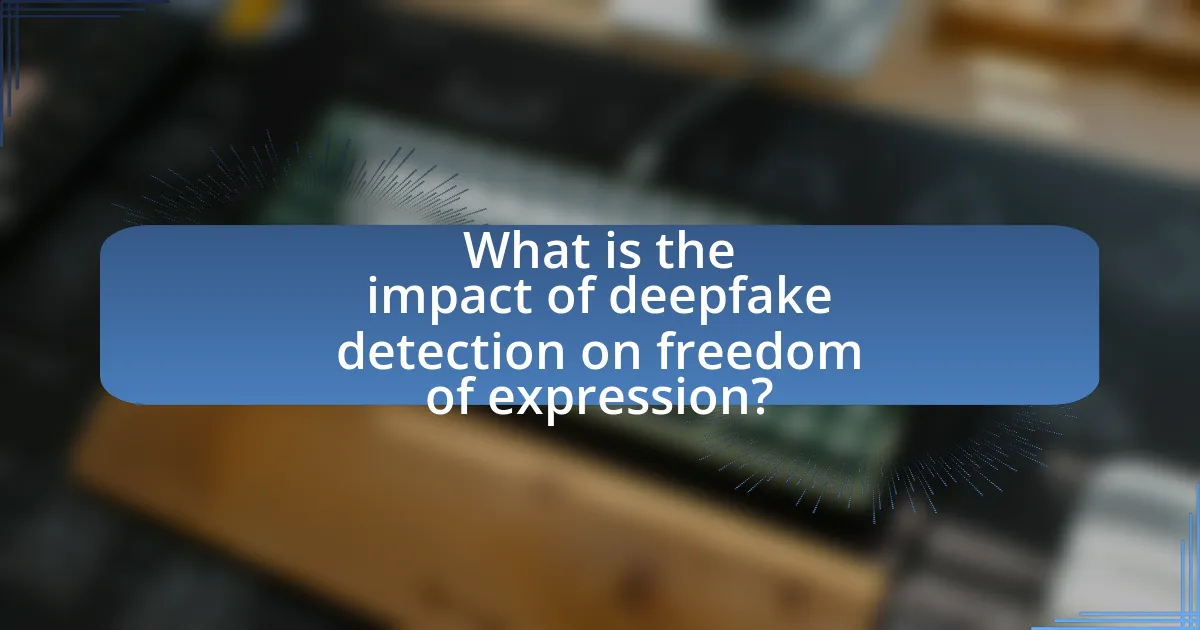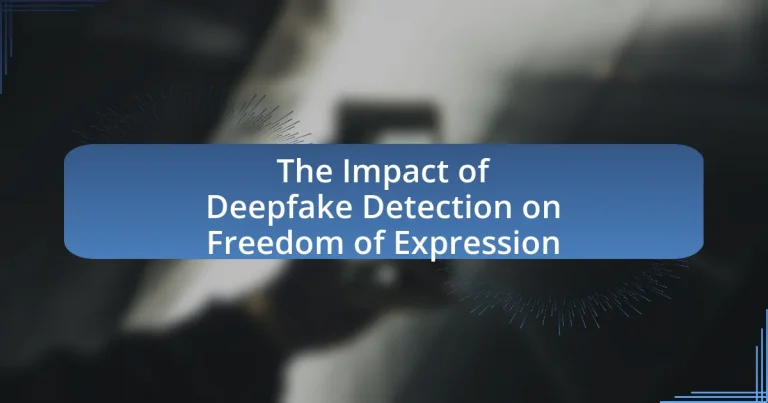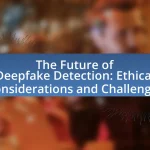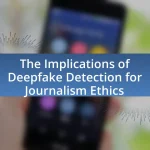The article examines the impact of deepfake detection on freedom of expression, highlighting the tension between safeguarding against misinformation and the potential for censorship. It discusses how advanced detection technologies can inadvertently restrict artistic expression and political discourse, as creators may fear repercussions for their work. The article also addresses the challenges posed by deepfake technologies in manipulating public perception, the ethical considerations surrounding detection methods, and the implications of legislation on both misinformation and creative freedoms. Additionally, it explores the societal implications of deepfake detection technologies, including their role in restoring trust in media and the importance of public awareness and responsible practices in addressing the deepfake phenomenon.

What is the impact of deepfake detection on freedom of expression?
Deepfake detection can restrict freedom of expression by imposing limitations on the creation and dissemination of digital content. As detection technologies advance, they may lead to increased censorship, where platforms remove or flag content deemed as deepfakes, regardless of its intent or context. This can stifle legitimate artistic expression, satire, and political discourse, as creators may fear repercussions for their work. Furthermore, the potential for misuse of detection tools by governments or corporations to suppress dissenting voices poses a significant threat to free speech. Studies indicate that while deepfake detection aims to combat misinformation, it can inadvertently create an environment where expression is curtailed under the guise of protecting truth.
How do deepfake technologies challenge freedom of expression?
Deepfake technologies challenge freedom of expression by enabling the creation of highly realistic but fabricated content that can mislead audiences and manipulate public perception. This manipulation can result in the spread of misinformation, which undermines trust in legitimate expressions and discourse. For instance, a study by the University of California, Berkeley, found that deepfakes can significantly alter viewers’ beliefs about political figures, thereby affecting democratic processes and public opinion. The potential for deepfakes to be used in defamation or harassment further complicates the landscape of free speech, as individuals may be unjustly targeted or silenced due to the false narratives created by such technologies.
What are the potential risks of deepfakes to public discourse?
Deepfakes pose significant risks to public discourse by undermining trust in media and information sources. The manipulation of video and audio content can lead to misinformation, where fabricated statements or actions attributed to public figures can mislead audiences and distort public perception. For instance, a study by the Brookings Institution highlights that deepfakes can exacerbate political polarization by creating false narratives that reinforce existing biases. Additionally, the potential for deepfakes to incite violence or social unrest is evident, as seen in instances where misleading content has triggered real-world consequences. These risks threaten the integrity of democratic processes and informed decision-making, ultimately compromising the quality of public discourse.
How can deepfakes influence political speech and opinion?
Deepfakes can significantly influence political speech and opinion by creating misleading representations of political figures, which can distort public perception and manipulate voter behavior. For instance, deepfake technology can fabricate videos that depict politicians saying or doing things they never actually did, leading to misinformation that can sway electoral outcomes. A study by the University of California, Berkeley, found that 85% of participants believed a deepfake video of a politician was real, highlighting the potential for deepfakes to undermine trust in authentic political discourse. This manipulation can erode democratic processes by fostering polarization and misinformation, ultimately impacting the integrity of political communication.
What role does deepfake detection play in safeguarding expression?
Deepfake detection plays a crucial role in safeguarding expression by ensuring the authenticity of digital content, thereby protecting individuals from misinformation and manipulation. The ability to identify deepfakes helps maintain trust in media, which is essential for free expression and informed public discourse. Research indicates that the prevalence of deepfakes can undermine the credibility of legitimate expressions, as seen in a 2020 study by the University of California, Berkeley, which highlighted how deepfakes can distort public perception and influence opinions. By effectively detecting these manipulated media, society can uphold the integrity of communication and support a healthy environment for freedom of expression.
How does deepfake detection technology work?
Deepfake detection technology works by analyzing digital content to identify signs of manipulation, utilizing algorithms that can differentiate between authentic and altered media. This technology employs machine learning models trained on large datasets of both real and fake videos, allowing it to recognize inconsistencies in facial movements, audio-visual synchronization, and pixel-level anomalies. For instance, a study published in 2020 by the University of California, Berkeley, demonstrated that deepfake detection systems could achieve over 90% accuracy by focusing on these specific features, validating the effectiveness of such approaches in identifying manipulated content.
What are the limitations of current deepfake detection methods?
Current deepfake detection methods face significant limitations, primarily due to their reliance on specific algorithms that may not generalize well across diverse deepfake techniques. These methods often struggle with detecting high-quality deepfakes that utilize advanced techniques like generative adversarial networks (GANs), which can produce highly realistic content that evades detection. Additionally, many detection systems are trained on limited datasets, making them less effective against novel or unseen deepfake variations. Research indicates that as deepfake technology evolves, detection methods must continuously adapt, yet many existing solutions lack the necessary flexibility and robustness to keep pace with rapid advancements in deepfake creation.
What are the ethical considerations surrounding deepfake detection?
The ethical considerations surrounding deepfake detection primarily involve the balance between preventing harm and preserving freedom of expression. Deepfake technology can be used maliciously to create misleading content that damages reputations or spreads misinformation, necessitating effective detection methods to mitigate these risks. However, the implementation of deepfake detection raises concerns about censorship and the potential for misuse by authorities to suppress legitimate speech. For instance, a study by the University of California, Berkeley, highlights that while detection tools can protect individuals from defamation, they may also inadvertently target political dissent or artistic expression, leading to ethical dilemmas regarding who decides what constitutes harmful content. Thus, the challenge lies in developing detection technologies that safeguard against abuse while respecting individual rights to free expression.
How does deepfake detection balance privacy and freedom of expression?
Deepfake detection balances privacy and freedom of expression by implementing technologies that identify manipulated content while safeguarding individuals’ rights to share information. This balance is crucial as deepfakes can infringe on personal privacy by misrepresenting individuals, yet the detection methods must not overly restrict legitimate expression. For instance, the use of AI-driven detection tools can help mitigate the risks of misinformation without imposing censorship, as seen in initiatives by organizations like the DeepTrust Alliance, which promotes responsible use of deepfake technology. These measures ensure that while individuals are protected from privacy violations, the broader public discourse remains open and free.
What are the implications of false positives in deepfake detection?
False positives in deepfake detection can lead to significant consequences, including the wrongful labeling of legitimate content as manipulated. This misclassification can damage reputations, undermine trust in media, and stifle freedom of expression by creating a chilling effect on content creation. For instance, a study by the University of California, Berkeley, found that erroneous deepfake identifications could result in unjust legal actions or social backlash against individuals whose authentic videos are mistakenly flagged. Such implications highlight the need for accurate detection methods to protect both individual rights and the integrity of information.
How does legislation impact deepfake detection and freedom of expression?
Legislation significantly influences deepfake detection and freedom of expression by establishing legal frameworks that govern the creation and distribution of deepfakes. Laws aimed at regulating deepfakes can enhance detection efforts by mandating the use of technology to identify manipulated content, thereby protecting individuals from misinformation and potential harm. For instance, California’s AB 730 law, enacted in 2019, specifically targets the malicious use of deepfakes in political campaigns, which underscores the legislative intent to safeguard electoral integrity while balancing the need for free expression. However, stringent regulations may also risk infringing on artistic and creative freedoms, as they could lead to censorship or overreach in the enforcement of deepfake laws. Thus, while legislation can bolster detection capabilities, it must carefully navigate the fine line between protecting individuals and preserving the fundamental right to free expression.
What laws currently address deepfakes and their detection?
Laws addressing deepfakes and their detection include the Malicious Deep Fake Prohibition Act of 2018, which criminalizes the use of deepfakes for malicious purposes, and various state laws, such as California’s AB 730, which prohibits the use of deepfakes to harm or defraud individuals. Additionally, the National Defense Authorization Act includes provisions for deepfake detection technologies to protect national security. These laws aim to mitigate the risks associated with deepfakes, particularly in contexts like misinformation and privacy violations.
How do different countries approach deepfake regulation?
Different countries approach deepfake regulation through a combination of legal frameworks, technological measures, and public awareness campaigns. For instance, the United States has focused on state-level legislation, with several states enacting laws that criminalize malicious deepfake use, particularly in contexts like election interference and non-consensual pornography. In contrast, the European Union is working on comprehensive regulations under the Digital Services Act, which aims to hold platforms accountable for harmful content, including deepfakes. Meanwhile, countries like China have implemented strict regulations requiring deepfake creators to register their identities and obtain licenses, emphasizing state control over digital content. These varied approaches reflect each country’s legal, cultural, and political contexts, influencing how they balance regulation with freedom of expression.
What are the societal implications of deepfake detection technologies?
Deepfake detection technologies have significant societal implications, particularly concerning trust in media and freedom of expression. These technologies can enhance the ability to discern authentic content from manipulated media, thereby fostering a more informed public. For instance, a study by the University of California, Berkeley, found that deepfake detection tools can reduce the spread of misinformation by up to 80%, which is crucial in maintaining the integrity of information shared in democratic societies. However, the deployment of these technologies also raises concerns about censorship and the potential suppression of legitimate artistic expression, as creators may fear their work could be misidentified as malicious deepfakes. Thus, while deepfake detection can protect against deception, it also poses challenges to the balance between safeguarding truth and preserving creative freedoms.
How can deepfake detection affect trust in media and information?
Deepfake detection can significantly enhance trust in media and information by providing tools to verify the authenticity of content. As deepfakes become more sophisticated, their potential to mislead audiences increases, undermining confidence in visual media. Effective detection methods, such as AI algorithms that analyze inconsistencies in video and audio, can help identify manipulated content, thereby restoring credibility to legitimate media sources. Research indicates that when audiences are aware of detection technologies, their trust in media improves; for instance, a study published in the journal “Nature” found that individuals exposed to deepfake detection tools were more likely to discern real from fake content, reinforcing the importance of transparency in media.
What role do social media platforms play in deepfake detection?
Social media platforms play a crucial role in deepfake detection by implementing advanced algorithms and community reporting systems to identify and mitigate the spread of manipulated content. These platforms utilize machine learning techniques to analyze videos and images for signs of alteration, which helps in flagging potential deepfakes before they can go viral. For instance, Facebook and Twitter have developed partnerships with third-party fact-checkers to review flagged content, enhancing the accuracy of detection efforts. Additionally, social media platforms often provide users with tools to report suspicious content, fostering community involvement in the detection process. This proactive approach is essential, as studies indicate that deepfakes can significantly impact public perception and trust, making timely detection vital for maintaining the integrity of information shared online.
What best practices can be adopted for responsible deepfake detection?
Best practices for responsible deepfake detection include implementing robust verification systems, utilizing advanced machine learning algorithms, and fostering collaboration among stakeholders. Verification systems should focus on cross-referencing content with reliable sources to confirm authenticity. Advanced machine learning algorithms can enhance detection accuracy by analyzing patterns and anomalies in video and audio data. Collaboration among technology companies, policymakers, and civil society is essential to establish ethical guidelines and share best practices, ensuring that detection efforts do not infringe on freedom of expression while addressing misinformation effectively.
How can individuals and organizations effectively use deepfake detection tools?
Individuals and organizations can effectively use deepfake detection tools by integrating them into their content verification processes. These tools analyze video and audio files for inconsistencies that indicate manipulation, such as unnatural facial movements or audio mismatches. For instance, a study by the University of California, Berkeley, found that advanced detection algorithms can identify deepfakes with over 90% accuracy, demonstrating their reliability. By employing these tools, users can safeguard against misinformation, enhance trust in media, and uphold freedom of expression by ensuring that authentic content is distinguished from deceptive material.
What strategies can enhance public awareness about deepfakes?
Educational campaigns can enhance public awareness about deepfakes by providing clear information on their existence, implications, and detection methods. These campaigns can utilize various platforms, including social media, schools, and community workshops, to reach diverse audiences. Research indicates that informed individuals are better equipped to identify deepfakes; for instance, a study by the University of California, Berkeley, found that educational interventions significantly improved participants’ ability to detect manipulated media. Additionally, collaboration with technology companies to develop user-friendly detection tools can empower the public to verify content authenticity, further increasing awareness and skepticism towards deepfakes.


